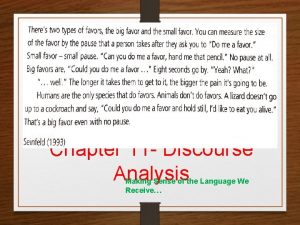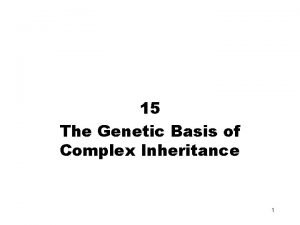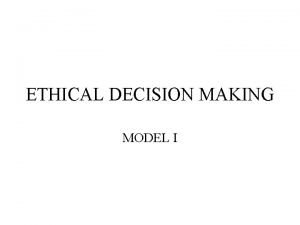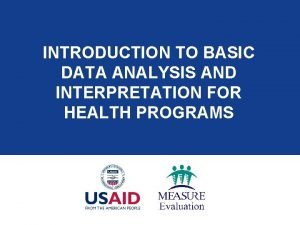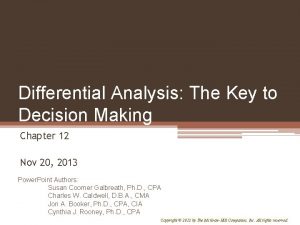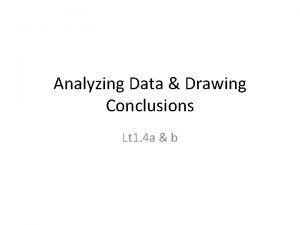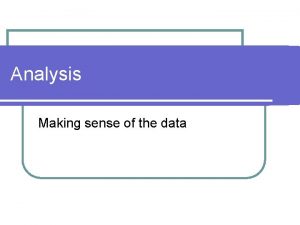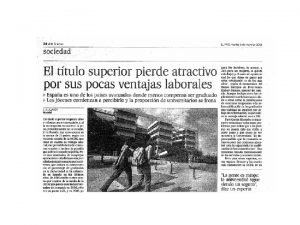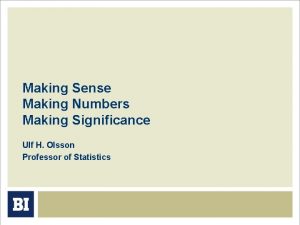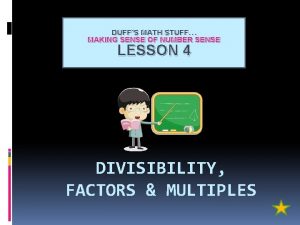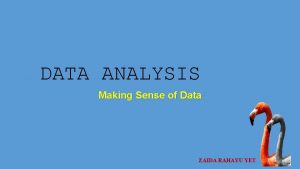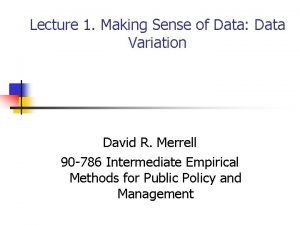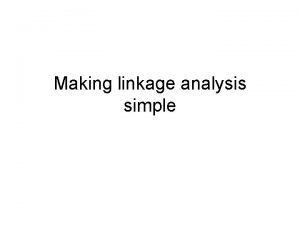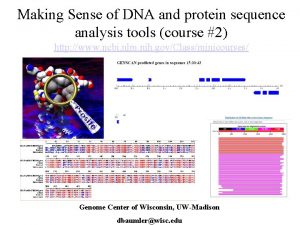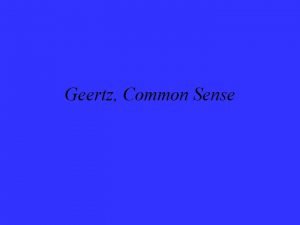Introduction Data Analysis Making Sense of Data 1






























- Slides: 30

+ Introduction: Data Analysis: Making Sense of Data 1. 1 Analyzing Categorical Data 1. 2 Displaying Quantitative Data with Graphs 1. 3 Describing Quantitative Data with Numbers Chapter 1: Exploring Data Section 1. 3 Describing Quantitative Data with Numbers The Practice of Statistics, 4 th edition - For AP* STARNES, YATES, MOORE

+ Section 1. 3 Describing Quantitative Data with Numbers Learning Objectives After this section, you should be able to… ü MEASURE center with the mean and median ü MEASURE spread with standard deviation and interquartile range ü IDENTIFY outliers ü CONSTRUCT a boxplot using the five-number summary ü CALCULATE numerical summaries with technology

The most common measure of center is the ordinary arithmetic average, or mean. Definition: To find the mean (pronounced “x-bar”) of a set of observations, add their values and divide by the number of observations. If the n observations are x 1, x 2, x 3, …, xn, their mean is: In mathematics, the capital Greek letter Σis short for “add them all up. ” Therefore, the formula for the mean can be written in more compact notation: Describing Quantitative Data n Center: The Mean + n Measuring


Another common measure of center is the median. In section 1. 2, we learned that the median describes the midpoint of a distribution. Definition: The median M is the midpoint of a distribution, the number such that half of the observations are smaller and the other half are larger. To find the median of a distribution: 1)Arrange all observations from smallest to largest. 2)If the number of observations n is odd, the median M is the center observation in the ordered list. 3)If the number of observations n is even, the median M is the average of the two center observations in the ordered list. Describing Quantitative Data n Center: The Median + n Measuring


Use the data below to calculate the mean and median of the commuting times (in minutes) of 20 randomly selected New York workers. Example, page 53 10 30 0 1 2 3 4 5 6 7 8 5 25 40 20 10 15 5 005555 0005 Key: 4|5 00 represents a 005 5 New York worker who reported a 45 minute travel time to work. 30 20 15 20 85 15 60 60 40 45 Describing Quantitative Data n Center + n Measuring

n The mean and median measure center in different ways, and both are useful. n Don’t confuse the “average” value of a variable (the mean) with its “typical” value, which we might describe by the median. Comparing the Mean and the Median The mean and median of a roughly symmetric distribution are close together. If the distribution is exactly symmetric, the mean and median are exactly the same. In a skewed distribution, the mean is usually farther out in the long tail than is the median. + Comparing the Mean and the Median Describing Quantitative Data n


Spread: The Interquartile Range (IQR) A measure of center alone can be misleading. n A useful numerical description of a distribution requires both a measure of center and a measure of spread. How to Calculate the Quartiles and the Interquartile Range To calculate the quartiles: 1)Arrange the observations in increasing order and locate the median M. 2)The first quartile Q 1 is the median of the observations located to the left of the median in the ordered list. 3)The third quartile Q 3 is the median of the observations located to the right of the median in the ordered list. The interquartile range (IQR) is defined as: IQR = Q 3 – Q 1 Describing Quantitative Data n + n Measuring

and Interpret the IQR + n Find Travel times to work for 20 randomly selected New Yorkers 10 30 5 25 40 20 10 15 30 20 15 20 85 15 60 60 40 45 5 10 10 15 15 20 20 20 25 30 30 40 40 45 60 60 65 85 Q 1 = 15 M = 22. 5 Q 3= 42. 5 IQR = Q 3 – Q 1 = 42. 5 – 15 = 27. 5 minutes Interpretation: The range of the middle half of travel times for the New Yorkers in the sample is 27. 5 minutes. Describing Quantitative Data Example, page 57

In addition to serving as a measure of spread, the interquartile range (IQR) is used as part of a rule of thumb for identifying outliers. Definition: The 1. 5 x IQR Rule for Outliers Call an observation an outlier if it falls more than 1. 5 x IQR above third quartile or below the first quartile. Example, page 57 0 1 2 For these data, 1. 5 x IQR = 1. 5(27. 5) = 41. 25 3 Q 1 - 1. 5 x IQR = 15 – 41. 25 = -26. 25 4 Q 3+ 1. 5 x IQR = 42. 5 + 41. 25 = 83. 75 5 Any travel time shorter than -26. 25 minutes or longer than 6 7 83. 75 minutes is considered an outlier. 8 In the New York travel time data, we found Q 1=15 minutes, Q 3=42. 5 minutes, and IQR=27. 5 minutes. 5 005555 0005 00 005 5 Describing Quantitative Data n Outliers + n Identifying



+ n The minimum and maximum values alone tell us little about the distribution as a whole. Likewise, the median and quartiles tell us little about the tails of a distribution. n To get a quick summary of both center and spread, combine all five numbers. n Use only if n>10. Definition: The five-number summary of a distribution consists of the smallest observation, the first quartile, the median, the third quartile, and the largest observation, written in order from smallest to largest. Minimum Q 1 M Q 3 Maximum Describing Quantitative Data The Five-Number Summary

The five-number summary divides the distribution roughly into quarters. This leads to a new way to display quantitative data, the boxplot. n Use only if n>10 How to Make a Boxplot • Draw and label a number line that includes the range of the distribution. • Draw a central box from Q 1 to Q 3. • Note the median M inside the box. • Extend lines (whiskers) from the box out to the minimum and maximum values that are not outliers. Describing Quantitative Data n + Boxplots (Box-and-Whisker Plots)

a Boxplot + n Construct Consider our NY travel times data. Construct a boxplot. n 10 30 5 25 40 20 10 15 30 20 15 20 85 15 60 60 40 45 5 10 10 15 15 20 20 20 25 30 30 40 40 45 60 60 65 85 Min=5 Q 1 = 15 M = 22. 5 Q 3= 42. 5 Max=85 Recall, this is an outlier by the 1. 5 x IQR rule Describing Quantitative Data Example



n The most common measure of spread looks at how far each observation is from the mean. This measure is called the standard deviation. Let’s explore it! Consider the following data on the number of pets owned by a group of 9 children. 1) Calculate the mean. 2) Calculate each deviation = observation – mean deviation: 1 - 5 = -4 deviation: 8 - 5 = 3 =5 Describing Quantitative Data n Spread: The Standard Deviation + n Measuring

Spread: The Standard Deviation 4) Find the “average” squared deviation. Calculate the sum of the squared deviations divided by (n-1)…this is called the variance. 5) Calculate the square root of the variance…this is the standard deviation. (xi-mean) 1 1 - 5 = -4 (-4)2 = 16 3 3 - 5 = -2 (-2)2 = 4 4 4 - 5 = -1 (-1)2 = 1 5 5 -5=0 (0)2 = 0 7 7 -5=2 (2)2 = 4 8 8 -5=3 (3)2 = 9 9 9 -5=4 (4)2 = 16 Sum=? “average” squared deviation = 52/(9 -1) = 6. 5 Standard deviation = square root of variance = (xi-mean)2 Describing Quantitative Data 3) Square each deviation. xi + n Measuring Sum=? This is the variance.

Spread: The Standard Deviation The standard deviation sx measures the average distance of the observations from their mean. It is calculated by finding an average of the squared distances and then taking the square root. This average squared distance is called the variance. Describing Quantitative Data Definition: + n Measuring




+ Outliers and Measures to Report n If outliers are present, then use the median as the measure of center and the IQR as the spread. These measures are resistant to outliers. n If no outliers are present, then use the mean as the measure of center and standard deviation as the measure of spread. n Example: Test scores 100, 95, 90, 60

n We now have a choice between two descriptions for center and spread n Mean and Standard Deviation n Median and Interquartile Range Choosing Measures of Center and Spread • The median and IQR are usually better than the mean and standard deviation for describing a skewed distribution or a distribution with outliers. • Use mean and standard deviation only for reasonably symmetric distributions that don’t have outliers. • NOTE: Numerical summaries do not fully describe the shape of a distribution. ALWAYS PLOT YOUR DATA! + Choosing Measures of Center and Spread Describing Quantitative Data n

+ Section 1. 3 Describing Quantitative Data with Numbers Summary In this section, we learned that… ü A numerical summary of a distribution should report at least its center and spread. ü The mean and median describe the center of a distribution in different ways. The mean is the average and the median is the midpoint of the values. ü When you use the median to indicate the center of a distribution, describe its spread using the quartiles. ü The interquartile range (IQR) is the range of the middle 50% of the observations: IQR = Q 3 – Q 1.

+ Section 1. 3 Describing Quantitative Data with Numbers Summary In this section, we learned that… ü An extreme observation is an outlier if it is smaller than –(1. 5 x. IQR) or larger than Q 3+(1. 5 x. IQR). Q 1 ü The five-number summary (min, Q 1, M, Q 3, max) provides a quick overall description of distribution and can be pictured using a boxplot. ü The variance and its square root, the standard deviation are common measures of spread about the mean as center. ü The mean and standard deviation are good descriptions for symmetric distributions without outliers. The median and IQR are a better description for skewed distributions.

+ Looking Ahead… In the next Chapter… We’ll learn how to model distributions of data… • Describing Location in a Distribution • Normal Distributions
 Making sense of discourse
Making sense of discourse Narrow sense heritability vs broad sense heritability
Narrow sense heritability vs broad sense heritability Narrow sense heritability vs broad sense heritability
Narrow sense heritability vs broad sense heritability What is inferring
What is inferring War making and state making as organized crime
War making and state making as organized crime Much madness is divinest sense analysis
Much madness is divinest sense analysis Poem tpcastt example
Poem tpcastt example Sonnet 18 rhyme scheme
Sonnet 18 rhyme scheme Link table qlikview
Link table qlikview Making multimedia
Making multimedia Simple unoccupied bed
Simple unoccupied bed Changing position of helpless patient definition
Changing position of helpless patient definition Conclusion of bed making ppt
Conclusion of bed making ppt Introduction in making portfolio
Introduction in making portfolio Introduction to ethical decision making
Introduction to ethical decision making Introduction of data analysis and interpretation
Introduction of data analysis and interpretation By making inferences based on analysis of a character
By making inferences based on analysis of a character Swot analysis decision making
Swot analysis decision making Making a fist by naomi shihab nye
Making a fist by naomi shihab nye Strategic analysis and choice in strategic management
Strategic analysis and choice in strategic management Sebastian lemire
Sebastian lemire Differential analysis the key to decision making
Differential analysis the key to decision making Differential analysis the key to decision making
Differential analysis the key to decision making Data quality is always a concern with secondary data
Data quality is always a concern with secondary data Introduction to data warehousing and data mining
Introduction to data warehousing and data mining Making science graphs and interpreting data
Making science graphs and interpreting data Greg linden
Greg linden Analyzing and drawing conclusions
Analyzing and drawing conclusions Procedures of data collection
Procedures of data collection Data preparation and basic data analysis
Data preparation and basic data analysis Data acquisition and data analysis
Data acquisition and data analysis
